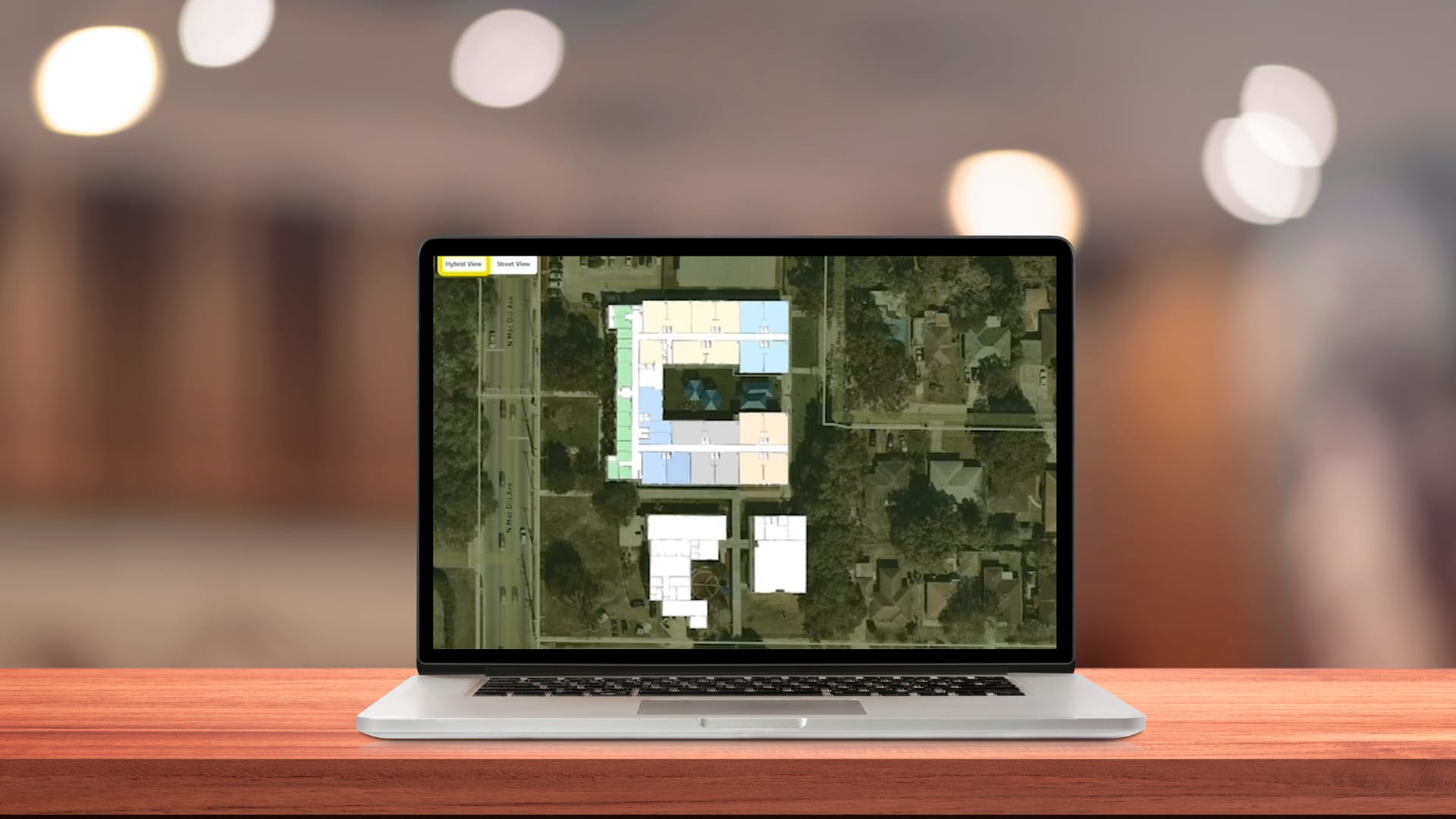
In September 2023, Texas House Bill 3 (HB3) went into effect. This bill aims to improve public school safety in the state. Among other efforts to create safe learning environments, the bill mandates that schools implement critical incident mapping technologies to facilitate rapid emergency response. Many Texas districts are using the funds allocated by HB3 to invest in digital maps that help them achieve compliance with HB3 and make their schools safer.
HB3 requires each school district and open-enrollment charter school to provide the following to the Department of Public Safety and all appropriate local law enforcement agencies and emergency first responders:
- an accurate map of each district campus and school building that is developed and documented in accordance with the standards in section 37.351 of the bill, which are related to developing site and floor plans, access control, and exterior door numbering.
- an opportunity to conduct a walk-through of each district campus and school building using the map.
Texas HB3 also allocates funds to support higher teacher salaries and increase incentives, disperse more money to high-poverty areas, and invest in improving student outcomes by supporting early reading and dual language programs and providing interventions for students with dyslexia.
Other specific provisions required by Texas HB3:
- mental health training for all employees who regularly interact with students
- the presence of at least one armed security officer during school hours
- agency monitoring of safety and security for the school district
New School Safety Requirements in Texas
In May 2023, the Texas Education Code authorized new School Safety Standards “to address minimum school safety standards that will better ensure the safety of students and staff in our public schools.” The Texas Education Agency also made funding available for districts to purchase technology and make improvements to meet these standards. The state awarded $1.4 billion in 2023 and 2024, including $1.1 billion in one-time funding to address new minimum school safety standards and other facilities-related safety improvements. This includes the 2023-2025 School Safety Standards Formulary Grant.
School safety investments that can be paid for with this funding include safety audits, silent panic alert technology, critical incident mapping technology, and other facilities-related safety improvements.
To comply with these new safety standards, the Texas Education Agency must specify and report the following information:
- best practices for the design and construction of new facilities
- best practices for the improvement, renovation, and retrofitting of existing facilities
- district improvement plans developed, evaluated, and revised annually (including mental health services, special education offerings, dropout reduction measures, and career education)
- training programs for school resource officers
- school safety and emergency operations plans
- protocols for establishing school safety teams
- other measures for supporting student mental health and building safety

Alyssa’s Law and Critical Incident Mapping
Alyssa’s Law addresses the critical issue of law enforcement response time when a life-threatening emergency occurs in a school. The law is named for Alyssa Aldeheff, who was killed in the Marjory Stoneman Douglas school shooting in 2018. Alyssa’s Law aims to shorten response times, save lives, and minimize trauma.
The law requires schools to install silent panic alarms linked directly to law enforcement. When integrated with digital maps, this technology enables first responders to pinpoint the location of the crisis and the most direct route to provide help.
Alyssa’s Law went into effect in Texas in June 2023. It passed unanimously in the Texas House and Senate and designated $17.1 million to fund the purchase and implementation of silent panic alarms.
Requirements in Texas
Silent Panic Alert Technology
Schools must invest in several technologies due to new school safety requirements in Texas.
Schools are required to provide every school with silent panic alert technology. These systems must facilitate immediate contact with the following:
- school and district emergency services
- emergency service agencies
- law enforcement agencies
- health departments
- fire departments
Schools must ensure employees have access to an electronic communication device and must also provide opportunities for walk-through inspections of safety measures in their facilities.
Critical Incident Mapping Technology
Schools must provide emergency response maps to the Department of Public Safety, law enforcement, and first responder agencies.
These maps must:
- be up-to-date and accurate
- include site and floor plans
- include access control locations
- include exterior door numbers
Dynamic digital maps include this information and enable school staff to view real-time changes and updates. When coupled with silent panic alert technology, digital maps allow first responders to see the locations of people needing assistance, a school’s safety assets, and other information critical to rapid emergency response.
Reporting Compliance
School districts must ensure that every facility complies with new Texas school safety standards. They must also develop and maintain documentation of every measure specified in SB11.
Texas Schools Achieve Compliance with Critical Incident Mapping and Silent Panic Alert Technology
Critical incident mapping enables first responders to respond quickly to precise locations. This technology performs precisely the functions for which Alyssa’s Law and Texas SB11 were designed. Dynamic digital maps include exhaustive information about school floor plans, grounds, safety measures, and safety assets. This information facilitates first responders’ rapid arrival and intervention during emergencies.
As such, digital critical incident mapping meets Texas requirements to “ensure district communications and technology infrastructure are adequate to allow for communication during an emergency.” They also allow schools to gather the data needed to meet compliance standards for safety and security audits, as the new legislation requires.
Texas districts can also comply with Alyssa’s Law and HB3 requirements with silent panic alert technology “that facilitates communication and information sharing between students, school personnel, and first responders in an emergency.”
CENTEGIX Safety Platform™: Comprehensive Safety for Texas Schools
The CENTEGIX Safety Platform integrates the CrisisAlert™ silent panic alarm system and Safety Blueprint™ critical incident mapping technology. These solutions work together to accelerate response times and create a culture of safety in Texas schools.
Safety Blueprint allows staff, administrators, and key personnel to access one digital map with every asset’s current and precise location. In combination with CENTEGIX CrisisAlert mobile panic button technology, Safety Blueprint also pinpoints the precise locations of alerts, thus ensuring that staff and students receive assistance as quickly as possible.
CENTEGIX Safety Blueprint is an intelligent digital mapping tool that:
- aids first responders in locating people and safety assets by initiating alerts on first responders’ mobile devices
- pinpoints precise locations of safety assets, including automated external defibrillators (AEDs), fire extinguishers, fire alarms, trauma/bleeding kits, and others
- specifies evacuation routes and reunification sites
- provides actionable insights to administrators tasked with creating school safety plans and policies
- combines with CENTEGIX Enhanced Visitor Management solution to ensure that administrators know who is in the building and where they are throughout the day
Achieve Compliance with CENTEGIX Safety Blueprint and CrisisAlert
CENTEGIX Safety Blueprint helps schools comply with Texas school safety reporting rules. The critical incident map provides a record of pertinent safety information, and staff can easily access this data for reporting purposes. In addition, CENTEGIX Safety Blueprint data provides actionable insights for administrators when allocating resources and creating safety protocols.
Districts implementing the CENTEGIX Safety Blueprint are empowered to meet and exceed legal requirements for maintaining critical incident maps. CrisisAlert—together with Safety Blueprint—also fulfills the criteria for silent panic alarm technology and digital mapping resources specified in Texas school safety grants. CENTEGIX technology enables schools to comply while providing the fastest possible emergency response.
CENTEGIX Safety Platform includes a suite of foundational safety solutions for robust school safety plans.
Request a demo today to learn more about how the CENTEGIX Safety Platform can help you comply with Texas school safety requirements.


